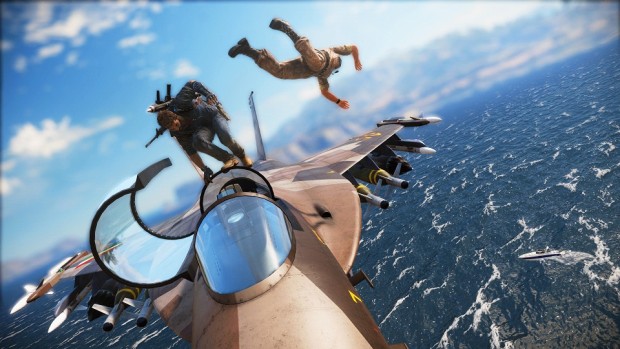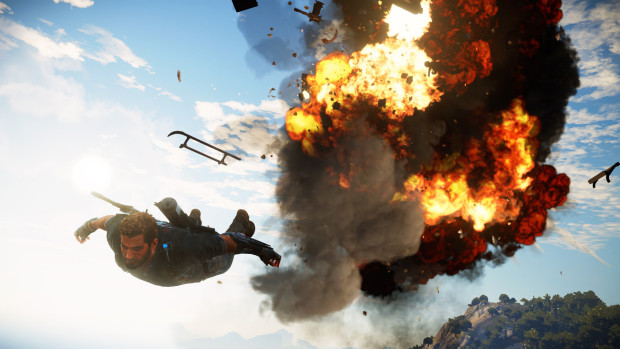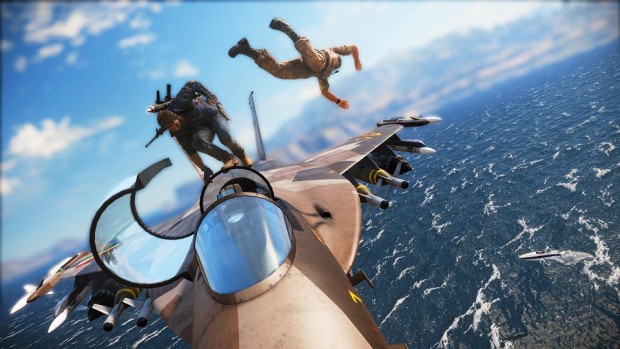


Avalanche Studio’s Just Cause 3 features a massive open world, littered with plenty of things to blow up and even more to shoot. The game uses modern-day rendering techniques and effects to visualize the gorgeous massive island and the waters that surround it.
For more help on Just Cause 3, read our Daredevil Jumps Locations, Challenges Guide and Unique Weapons Locations.
Our guide will help you familiarize yourself with some of the graphic settings that dictate the game’s visuals and performance. With each setting, we tell you the performance impacts, as well as how they affect the overall visual quality of Just Cause 3.
Anisotropic Filtering
Anisotropic filtering controls the sharpness of textures, especially those seen in the distance. It has a noticeable impact on quality, but overall minimal impact on performance. With any decent graphics card, anisotropic filtering should be kept at 16x.
Antialiasing
Antialiasing removes the jagged edges of polygons and textures in the game. Just Cause 3 uses a low-cost Post-Process antialiasing system (PPAA). At its most expensive (SMAA T2X), antialiasing will on average reduce the frame-rate by 3 to 4 fps max, so having it is always recommended.
Bokeh Depth of Field
Boken Depth of Field is a cinematic effect that gives an out-of-focus effect. There is absolutely no noticeable difference visually with on and off.
Despite not doing anything blatantly visible, the effect does cut down frame-rates by 3-5 frames per second, so having it off for that extra bit of juice is not a bad idea.
Global Illumination
This effect allows light to bounce off reflecting objects that are not light-sources. This certainly increases the realism. However, Global Illumination is a very performance-heavy effect.
You should consider using it only if you have a high-end graphics card and powerful CPU.
Level of Detail
LOD or Level of Detail alters the polygon count and geometric detail of objects in the environment. Higher levels of detail greatly add to the realism of the game.
The difference in performance between Very High and Low is around 9 frames, but the drop in quality is also visible. Keeping LOD at High is recommended for most PCs.
Screen Space Reflections
Every lustering object in Just Cause 3 reflects explosions, effects, and lighting, adding to the immersion and realism.
Screen Space Reflections greatly boosts the image quality to a phenomenal extent, but also has a massive impact (roughly 20 frame-rates difference between on/off in dense areas) on performance.
Disabling it though will virtually degrade every scene in the game.
Shadow Quality
Shadows tend to hog a lot of frame-rates in conventional games, but Just Cause renders them very efficiently. There’s a surprisingly small amount of performance difference between Low and Very High (5-6 fps max), but the difference is quality is massive.
It’s generally recommended to keep shadows on Very High, or at worst High.
SSAO
Ambient Occlusion is a shading technique that casts contact shadows where two surfaces or objects meet. This gives objects an extra bit of realistic depth and three-dimensional aspect.
Just Cause 3 uses very good SSAO implementation that can have a performance impact of 7-8 frames, but the visual quality is also significantly improved.
Texture Quality
Texture quality determines the resolution of the textures used in the world, and the detail level of the textures. Changing the texture quality has negligible impact on performance, but a massive one on visual quality.
There’s absolutely no reason to go below Very High, unless you’re running Just Cause 3 on a potato.
Water Detail
The water in Just Cause 3 is next-generation stuff. Avalanche studios worked closely with Nvidia to develop the ultra-realistic Nvidia WaveWorks, which simulates water in a far more believable manner than other games.
These include sub-effects like foam, caustics, God Rays, and other eye-candy, which can cost you up to 16 fps (between Low and Very High).
Note that WaveWorks primarily runs on the CPU, with additional effects (such as the ones mentioned above) run off the GPU. Keep this in mind and adjust your levels accordingly.
Water Tessellation
Tessellation further adds extra details to the water waves with special shaders. If you have relatively new GPUs (Nvidia 900 series or AMD R9 series), you shouldn’t have to worry about turning this effect off, as these GPUs handle tessellation very well.




 Just Cause 3 Unique Vehicles Locations Guide
Just Cause 3 Unique Vehicles Locations Guide Just Cause 3 Di Ravello Tapes Locations 'Diary of the Madman Guide
Just Cause 3 Di Ravello Tapes Locations 'Diary of the Madman Guide Just Cause 3 PC Tweaks Guide to Improve Performance and Graphics
Just Cause 3 PC Tweaks Guide to Improve Performance and Graphics Just Cause 3 DareDevil Jumps Locations 'Consummate Daredevil Guide
Just Cause 3 DareDevil Jumps Locations 'Consummate Daredevil Guide Just Cause 3 Insula Striate Liberation 'Heart of Stone' Guide
Just Cause 3 Insula Striate Liberation 'Heart of Stone' Guide